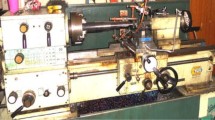Abstract
In this paper, FEM is used to investigate turning process on AISI 1020 steel by considering the effect of cutting speed, depth of cut, and feed on the surface roughness. Two different tools are used for turning, i.e. single-point cutting tool (HSS) and insert tool (CNMA WC). The FEM software DEFORM-2D is used to simulate the turning process. The results obtained by the simulation have been compared and analyzed with the experimental values. Overall minimum and maximum deviation between FEM model and experiment for single-point tool (HSS) are 3.74 and 22.8 %, respectively, and similarly for insert tool (CNMA WC) are 1.15 and 11.8 %, respectively.

Similar content being viewed by others
References
Dogra M., Sharmab V.S., Durejac J.: Effect of tool geometry variation on finish turning—a review. J. Eng. Sci. Technol. Rev. 4(1), 1–13 (2011)
Mustafa A.Y., Ali T.: Determination and optimization of the effect of cutting parameters and workpiece length on the geometric tolerances and surface roughness in turning operation. Int. J. Phys. Sci. 6(5), 1074–1084 (2011)
Settineri L., Levi R.: Surface properties and performance of multilayer coated tools in turning Inconel. Ann. CIRP 54(1), 515–518 (2005)
Paulo Davim J., Figueira L.: Comparative evaluation of conventional and wiper ceramic tools on cutting forces, surface roughness, and tool wear in hard turning AISI D2 steel. Proceedings of the Institution of Mechanical Engineers. Part B. J. Eng. Manuf. 221(4), 625–633 (2007)
Nalbant M., Altın A., Gokkaya F.: The effect of cutting speed and cutting tool geometry on machinability properties of nickel-base Inconel-718 super alloys. Mater. Design 28, 1334–1338 (2007)
Tangena G., Wijnhoven P.J.M.: Finite element calculations on the influence of surface roughness on friction. Wear 103, 345–354 (1985)
Faulkner A., Arnell R.D.: The development of a finite element model to simulate the sliding interaction between two, three-dimensional, elastoplastic, hemispherical asperities. Wear 242, 114–122 (2000)
Ceretti E., Lazzaroni C., Menegardo L., Altan T.: Turning simulations using a three-dimensional FEM code. J. Mater. Process. Technol. 98, 99–103 (2000)
Singamneni S.B.: A mixed solution for the three-dimensional temperature distribution in turning inserts using finite and boundary element techniques. J. Mater. Process. Technol. 166, 98–106 (2005)
Xie L.-J., Schmidt J., Schmidt C., Biesinger F.: 2D FEM estimate of tool wear in turning operation. Wear 258, 1479–1490 (2005)
Wu H.Y., Lee W.B., Cheung C.F., To S., Chen Y.P.: Computer simulation of single-point diamond turning using finite element method. J. Mater. Process. Technol. 167, 549–554 (2005)
Grzesik W., Bartoszuk M., Nieslony P.: Finite element modelling of temperature distribution in the cutting zone in turning processes with differently coated tools. J. Mater. Process. Technol. 164–165, 1204–1211 (2005)
Suraratchai M., Limido J., Mabru C., Chieragatti R.: Modelling the influence of machined surface roughness on the fatigue life of aluminium alloy. Int. J. Fatigue 30, 2119–2126 (2008)
Sigmund Kyrre Ås, Bjørn Skallerud, Bård Wathne Tveiten,: Surface roughness characterization for fatigue life predictions using finite element analysis. Int. J. Fatigue 30, 2200–2209 (2008)
Basim, Khidhir, A.; and Bashir Mohamed,: Study of cutting speed on surface roughness and chip formation when machining nickel-based alloy. J. Mech. Sci. Technol. 24(5), 1053–1059 (2010)
Mohammadpour M., Razfar M.R., Jalili Saffar R.: Numerical investigating the effect of machining parameters on residual stresses in orthogonal cutting. Simul. Model. Practice Theory 18, 378–389 (2010)
AttanasioaA. Ceretti E., Fiorentinoa A., Cappellinia C., Giardinib C.: Investigation and FEM-based simulation of tool wear in turning operations with uncoated carbide tools. Wear 269, 344–350 (2010)
Fang N., Fang G.: Theoretical and experimental investigations of finish machining with a rounded edge tool. J. Mater. Process. Technol. 191, 331–334 (2007)
Ship-Peng L.: An analysis of cutting under different rake angles using the finite element method. J. Mater. Process. Technol. 105, 143–151 (2000)
Özel T., Zeren E.: Finite element analysis of the influence of edge roundness on the stress and temperature fields induced by high speed machining. Int. J. Adv. Manuf. Technol. 35(3–4), 255–267 (2007)
Yen Y.C., Sartkulvanich P., Altan T.: Finite element modeling of roller burnishing process. CIRP Ann. Manuf. Technol. 54(1), 237–240 (2005)
Author information
Authors and Affiliations
Corresponding author
Rights and permissions
About this article
Cite this article
Stalin John, M.R., Shrivastava, K., Banerjee, N. et al. Finite Element Method-Based Machining Simulation for Analyzing Surface Roughness During Turning Operation with HSS and Carbide Insert Tool. Arab J Sci Eng 38, 1615–1623 (2013). https://doi.org/10.1007/s13369-013-0541-1
Received:
Accepted:
Published:
Issue Date:
DOI: https://doi.org/10.1007/s13369-013-0541-1




